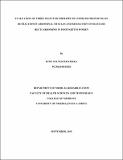UNNSpace Repository
Evaluation of Three Selected Therapeutic Exercise Protocols in Retraction of Abdominal Muscles And Resolution of Diastasis Recti Abdominis in Postpartum Women
JavaScript is disabled for your browser. Some features of this site may not work without it.
| dc.contributor.author | Igwe, Sylvester Emeka
|
|
| dc.date.accessioned | 2017-11-03T14:04:04Z | |
| dc.date.available | 2017-11-03T14:04:04Z | |
| dc.date.issued | 2014-09 | |
| dc.identifier.uri | http://repository.unn.edu.ng:8080/xmlui/handle/123456789/5652 | |
| dc.description.abstract | This study was undertaken to evaluate isotonic, isometric and isotonic/isometric combination exercises in the retraction of abdominal muscles,and to assess the effectiveness of isometric contraction in resolving diastasis recti abdominis in postpartum women. A total of ninetywomenof four to eight weeks postpartum who consented to the study were randomly selected. They comprised respectivelyof 29 (32.2%) primigravids and 61 (67.8%) multigravids with the mean age of 32.59±5.79 years.A batch of 60 women were grouped into four:group A, 15(Isotonic abdominal exercises), group B, 15 (Isometric abdominal exercises), group C, 15 (combination of isotonic and isometric exercises) and control group D, 15 who received no abdominal exercises for six weeks. Another batch of30 subjects for diastasis recti abdominis study were grouped into two: 23 (isometric group A) and 7 (control group B). For subjects in the first category, both initial and weekly abdominal girth were measured and recorded for six consecutive weeks, using a portable electronic myotape device, while category two subjects had initial and weekly inter-recti distance (IRD)measured at 2.5cm above and below the umbilicususing ultrasound imaging technique. The category one results showed no significant decrease (p> 0.05) in the mean abdominal girth at baseline, first week and second week across the groups. However, there was a significant decrease (p< 0.05) in the mean abdominal girth across the groups at the third to sixth weeks. The mean abdominal retraction value in the multigravid group (7.0 ± 1.8cm) was found to be higher than that of the primigravid group (6.2 ±1.9cm) and this was consistent through the periodsand statistically significant (p< 0.05). The mean abdominal retraction index (RI ≥ 50%) was achieved by all groups except the control, at different periods. An overall view of category two results revealed statistically significant increase in closure of inter-recti distance of experimental group over the control, though not statistically significant (p< 0.05). There was significant relationship between closure at the upper and lower margins of the umbilicus(p < 0.05), in favour of the former.Closure of inter-recti distance was also significant (p< 0.05) at the fourth week when compared with the baseline. Result also showed that younger postpartum women achieved significantly better recovery from diastasis recti abdominis than their older counterparts. Thus these therapeutic exercise qualities should be recommended for the retraction of abdominal muscles as well as resolution of diastasis recti abdominis in postnatal women. | en_US |
| dc.language.iso | en | en_US |
| dc.publisher | University of Nigeria | en_US |
| dc.subject | Igwe Sylvester Emeka | en_US |
| dc.subject | Therapeutic Exercise | en_US |
| dc.subject | Gross Anatomy | en_US |
| dc.subject | Isotonic Contraction | en_US |
| dc.title | Evaluation of Three Selected Therapeutic Exercise Protocols in Retraction of Abdominal Muscles And Resolution of Diastasis Recti Abdominis in Postpartum Women | en_US |
| dc.type | Thesis | en_US |
